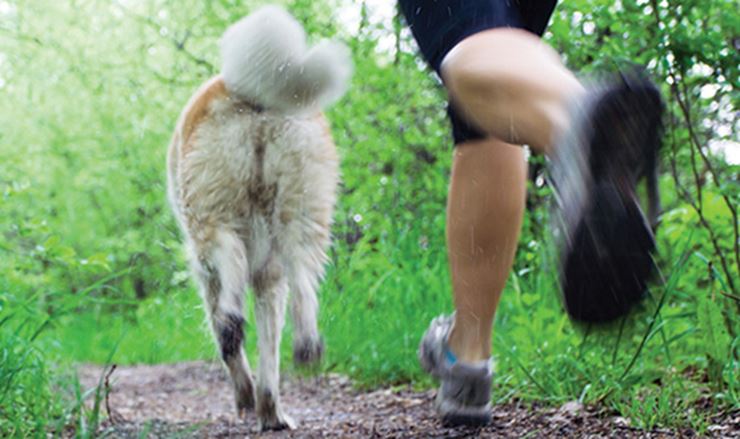
10 Benefits of Exercising with Your Dog
CAUTION: Always discuss your dog’s exercise needs with a trusted veterinarian, and be sure to consult your doctor before beginning any exercise regimen.
Okay, so you’ve slacked off a bit since New Year’s, right?
You hit that workout hard for the first two weeks in January, but now—well, you’re at least still thinking about health. Those new tennis shoes in the corner are still stiff from neglect, aren’t they?
And what about that new leash you bought Rover—still in the packaging?
The best way to combat fitness fatigue is to work small exercises into part of your everyday life. Small changes make a big difference. Make it fun, and make it a mutual accountability between you and Rover. Experiment with several ideas to find an activity that matches you and your dog’s style.
Daily aerobic exercise (exercising at a “panting” level) is extremely beneficial for dogs—and hitting a panting level never hurt humans either, since an increased heart rate can decrease the likelihood of health problems.
Create an incentive plan—with a healthy reward—healthy food or a toy. (Junk food does not count as a healthy reward, just so you know.) If you stick with it, you’ll find that adequate, regular exercise is itself a reward for you and Rover, with numerous health benefits.
1. Healthy Weight
Obvious, right?
Still, it’s worth mentioning again. Exercise helps maintain healthy weight and prevent excess pounds from creeping up in humans and dogs.
Exercise burns calories. Intensity levels determine the number of calories burned. However, some exercise burns more calories than no exercise.
The trick is to be more active throughout your daily routine, and that happens when you are more mindful of your daily activity.
If there are stairs at the park, take them—maybe even twice in one walk with Rover. When playing fetch or chase, play on a hill or slope, that way you and Rover get that little extra push in your exercise routine. Spice up your favorite walk with “intervals”— walk/jog briskly for one minute and then walk at a regular pace for two.
2. Reduce Heart Disease
Exercise ramps up blood flow, sending oxygen and nutrients to body tissues, which aids overall cardiovascular functioning.
In humans, exercise increases HDL (“good”) cholesterol and reduces LDL (“bad”) cholesterol, as well as lowering blood pressure.
Dogs also experience a reduced risk of heart disease with regular doses of exercise, since the increased blood flow strengthens the heart muscle and heart valves, preventing congestive heart failure.
3. Digestive Health
Coupled with a healthy diet, regular exercise stimulates the digestive organs to move correctly, which improves digestion.
4. Fight Depression
No matter which side of the argument you agree with (whether pets really experience depression or not), the scientific proof of improved mood after exercise is irrefutable.
The increased blood flow to the brain, in short, balances out mood by releasing positive chemicals (endorphins)—for dogs and humans.
5. Reduce Stress and Anxiety
Stress and anxiety are major contributors to health problems in pets and humans. Exercise redirects the negative mental focus (anxiety) into a physical release, thus improving total health.
6. Insomnia Treatment
Expending energy during the day allows the body to rest more efficiently at night. Adequate exercise is one suggested remedy for insomnia.
7. Build Confidence
The endorphins released during exercise facilitate a positive, “feel-good” experience, which builds confidence in humans and dogs.
8. Mental Stimulation and Socialization
Going for that daily walk or play time gets you and Rover out in the world. During these times, you’ll often encounter other dogs and people, providing ample opportunities for Rover to practice appropriate socialization.
Also, the environment of being in the open air stimulates mental function. Don’t be afraid to take a new path and give a little more “wait” time while Rover explores all the new images and smells.
9. Behavioral Improvement
So, most of us have been there—when we come home to ripped couch cushions or chewed end tables.
Behavioral issues in dogs (and humans) sometimes stem from lack of proper stimulation. Exercise provides restless dogs and humans with a healthy outlet for pent-up energy.
Pets who lack proper amounts of daily exercise often find creative, destructive habits to replace the lacking physical (and mental) exercise. Chewing, excessive jumping, over-excitability, garbage-rummaging, digging, hyperactivity, excessive barking, etc., indicate a possible need for physical engagement.
10. Bonding Time
Yes, more than all the health benefits regular exercise brings to you and Rover, the most rewarding is the bond you foster when you spend the time together. Building a trust between you and Rover increases the longevity of your friendship.
Do you exercise with your dog? What other benefits have you seen as a result?












